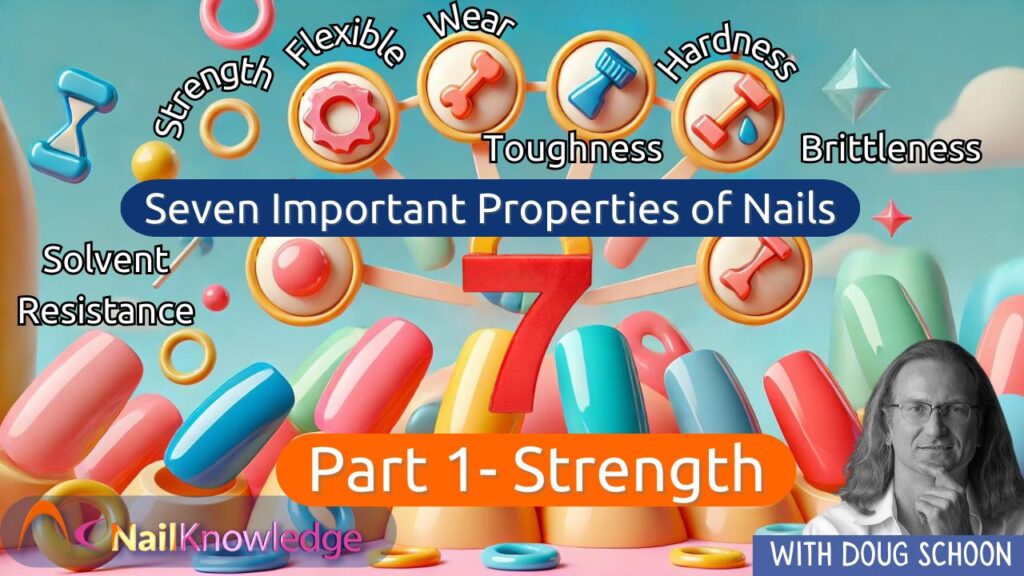There are seven important properties of natural and artificial nails that are often responsible for how your nails will behave in real-world situations.
These seven key properties, strength, hardness, flexibility, toughness, brittleness, solvent resistance, and wear are crucial for understanding how both natural and artificial nails perform and behave.
Interestingly, these same properties apply to both natural and artificial nail coatings. For instance, if a client snags their natural or artificial nail on something, how will that nail respond? Will it tear or crack or will it resist being damaged?
This often depends on one or more of these important properties. Let’s review them, so you can have a deeper understanding of how these properties can affect all types of nails.
Properly understanding these properties will help everyone, from nail enthusiasts to professionals, make better choices for nail care and maintenance.
Understanding Nail Strength: The First Key Property of Natural and Artificial Nails
- Strength – What is Strength?
We use the word all the time in many ways; everything from the strength of a person’s character to muscle strength training; but nails don’t have muscles.
Of course, they certainly can have lots of character as any fan of nail art knows and they can certainly be strong, in fact they can be too strong, even dangerously strong!
Strength is defined as the ability of a material to “resist breaking under the stress of a heavy load or impact”. Bridges are good examples. They must be strong enough to hold all the crossing cars. In this case, the cars are the heavy load.
Drop a wine glass on a ceramic tile floor and it will not have the strength to resist the impact. For the same reason, a hard-ceramic tile will break if a heavy frying pan were dropped. The strength of a tree branch allows it to resist the extra load created during heavy wind. Our muscles must be strong enough to resist tearing apart when moving heavy loads. The strength of hair allows it to resist breakage while being brushed.
Why Nail Plates Need Strength—But Not Too Much
Why do nail plates need to be strong? That is because we use them like tools. All the bending, picking, prying, poking, scratching and clawing we do with our nails is proof of their strength.
Strength isn’t the only property that nail plates must possess. There are several other important properties to consider. Would you want nails like titanium alloy? It is very strong, but we don’t want or need our nail plates to be that strong. Not so strong that the nail plate would rip away from the nail bed and matrix area if caught on something. It would be better if it broke instead, since the alternative would not be fun or pleasant and could cause serious, possibly irreversible damage to the nail bed and matrix. Also, if client’s nails were that hard and inflexible, they could poke out someone’s eye, maybe their own!
Of course, we want strong nails, but not quite that strong. Right?
It is important for the nail plate to break under certain conditions, so they must not be too strong. Nail plates are designed to break at some point before more serious, potentially permanent damage can occur.
The Issue with MMA: Why It’s Too Strong for Artificial Nails
This is one of the problems of the use of methyl methacrylate monomer (MMA), which is sometimes used as an ingredient in certain monomer liquid and polymer powder (L&P) formulations. MMA is too strong. Rather than break when impacted, the force will cause the natural nail to crack, rather than the artificial nail coating.
In other words, an MMA nail coating is too strong to function properly as an artificial nail. There are other problems with the properties of MMA that make it an undesirable ingredient for artificial nails which are discuss in this blog post MMA and the Nail Industry.
Explore More Key Properties of Nails in Our 7-Part Series:
- Nail Strength – Discover how the strength of nails impacts their performance and durability.
- Nail Hardness – Understand the crucial role of hardness in nail health and how to maintain the perfect balance.
- Nail Flexibility – Understand the importance of flexibility in preventing nail breakage and maintaining resilience.
- Nail Toughness – Find out what makes nails tough and how this property differs from strength and hardness.
- Nail Brittleness – Learn what causes brittleness in nails and how to prevent it.
- Nail Solvent Resistance – Explore how nails can resist damage from chemicals and solvents.
- Nail Wear – Understand the factors that affect how well nails withstand regular use and environmental exposure.


